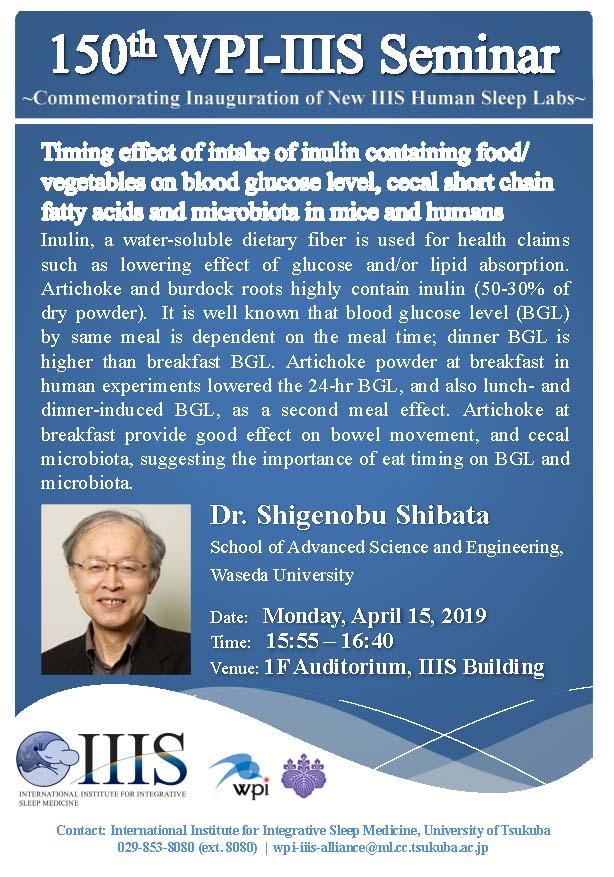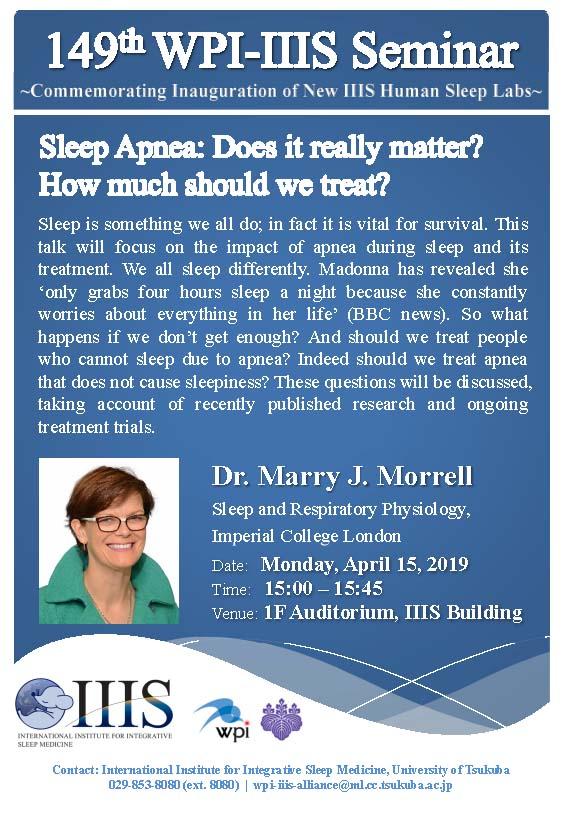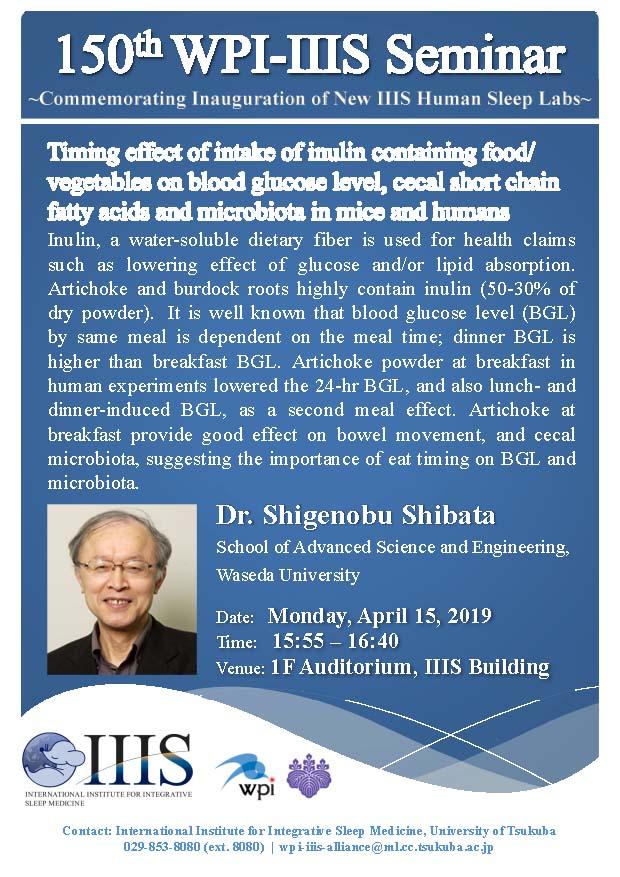1
EVENTS
The 148th, 149th and 150th WPI-IIIS seminar
Details
| Date | Monday, April 15, 2019 |
| Time | 14:05-14:50 The 148th WPI-IIIS Seminar 15:00-15:45 The 149th WPI-IIIS Seminar 15:55-16:40 The 150th WPI-IIIS Seminar *These WPI-IIIS Seminars are held as a part of the opening ceremony for IIIS Human Sleep Lab. |
| Venue | 1F Auditorium, IIIS Building, University of Tsukuba |
| Access | Take a bus bound for "Tsukuba Daigaku Chuo" or the "University Loop-line On-campus Bus [Tsukuba Daigaku Junkan Bus]" and get off at Oikoshi Gakusei Shukusha Mae |
| Contact | International Institute for Integrative Sleep Medicine Phone: 029-853-8080 (ext.8080) |
The 148th WPI-IIIS Seminar
| Speaker | Dr. Kingman P. Strohl ( Departments of Medicine, Physiology & Biophysics, and Oncology, Case Western Reserve University ) |
| Subject | "Mechanisms of Current and Emerging OSA Therapy" |
| Summary | Obstructive sleep apnea (OSA) is the appearance of recurrent apneas and hypopneas during sleep. It is a complex syndrome with a causal mechanism of airway closure or near closure, due to a reduced muscle tone during sleep. A second element is the gain of the system, when at termination there occurs an excessive ventilatory overshoot (a high gain), and then recovery leads to a fall back below a threshold for keeping the airway open. Another contribution is poor recruitment of drive to muscles involved in reopening an obstructed airway, and sleep itself, i.e. a tendency for early arousal from sleep. Treatment can bypass any obstruction with a tracheostomy or, if it is nasopharyngeal obstruction, place a flexible tube through one nasal passage with Nastent (Seven Dreamers). Continuous positive airway pressure (CPAP) or oral appliances stent the airway open. Surgery on the anatomy or weight loss also lower the tendency for airway closure. A new approach is to directly stimulate the hypoglossal nerve and actively open the airway, leaving anatomy and loop gain alone. Future directions being studied are pharmacologic approaches that can prevent the loss of muscle tone with sleep, lower loop gain, and/or prevent early arousals, while promoting sleep; however, no drugs have reached a regulatory threshold. |
The 149th WPI-IIIS Seminar
| Speaker | Dr. Marry J. Morrell ( Sleep and Respiratory Physiology, Imperial College London ) |
| Subject | "Sleep Apnea: Does it really matter? How much should we treat?" |
| Summary | Sleep is something we all do; in fact it is vital for survival. This talk will focus on the impact of apnea during sleep and its treatment. We all sleep differently. Madonna has revealed she 'only grabs four hours sleep a night because she constantly worries about everything in her life' (BBC news). So what happens if we don't get enough? And should we treat people who cannot sleep due to apnea? Indeed should we treat apnea that does not cause sleepiness? These questions will be discussed, taking account of recently published research and ongoing treatment trials. |
The 150th WPI-IIIS Seminar
| Speaker | Dr. Shigenobu Shibata ( School of Advanced Science and Engineering, Waseda University ) |
| Subject | "Timing effect of intake of inulin containing food/ vegetables on blood glucose level, cecal short chain fatty acids and microbiota in mice and humans" |
| Summary |
Inulin, a water-soluble dietary fiber is used for health claims such as lowering effect of glucose and/or lipid absorption. Artichoke and burdock roots highly contain inulin (50-30% of dry powder). It is well known that blood glucose level (BGL) by same meal is dependent on the meal time; dinner BGL is higher than breakfast BGL. Artichoke powder at breakfast in human experiments lowered the 24-hr BGL, and also lunch- and dinner-induced BGL, as a second meal effect. Artichoke at breakfast provide good effect on bowel movement, and cecal microbiota, suggesting the importance of eat timing on BGL and microbiota. |



December 2025
| Mon | Tue | Wed | Thu | Fri | Sat | Sun |
|---|---|---|---|---|---|---|
2
|
3
|
4
|
5
|
6
|
7
|
|
8
|
9
|
10
|
11
|
12
|
13
|
14
|
15
|
16
|
17 |
18 |
19 |
20
|
21
|
22
|
23
|
24 |
25
|
26
|
27
|
28
|
29
|
30
|
31
|


